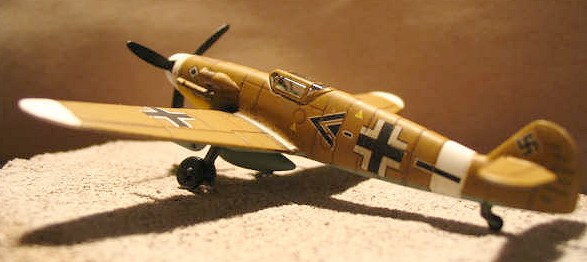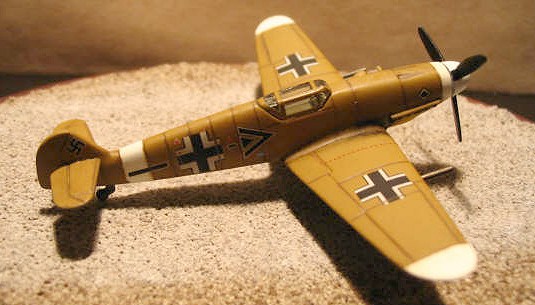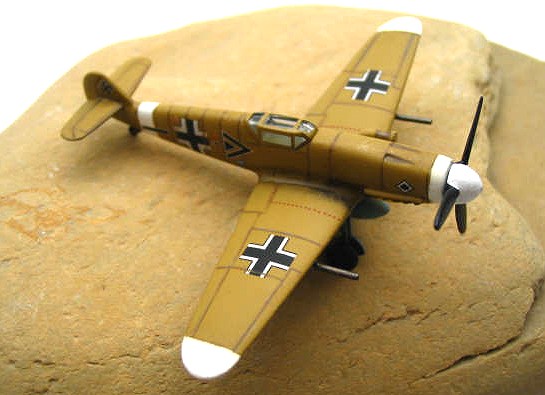
| KIT: | Eduard 1/144 Bf-109F |
| KIT #: | 4405 |
| PRICE: | $2.00 (already started) |
| DECALS: | Two options |
| REVIEWER: | Steven Yau |
| NOTES: |

| HISTORY |
First of all, this kit has already been reviewed in details by the webmaster before. But since I had so much fun building this tiny kit, I thought it deserves another article about it.
I purchased the kit at a local IPMS show back in September for $2.00, and thatís Canadian dollar! With a price lower than some Starbucks coffees, how could I refuse?
| THE KIT |
Even though Scott did an excellent job with the descriptions of the original kit, mine came with a little twist. The kit was started by the owner with the fuselage, tailplanes and the wings already glued together. So I really didnít have much to add since there are so very few parts to this kit.
| CONSTRUCTION |
 With
the wings, tailplanes and the fuselage were already put together I
proceeded to sand/scrap the seams. Careful sanding eliminated the need to
re-scribe any panel lines. As mentioned in Scottís review, itís hard to
decide if Eduard wants this to be an F or G version of the 109, so I left
everything as is without being too picky. However, I decided to use the
supercharger intake and the canons, just because I need to feel that I did
something! So I guess that makes mine a G version.
With
the wings, tailplanes and the fuselage were already put together I
proceeded to sand/scrap the seams. Careful sanding eliminated the need to
re-scribe any panel lines. As mentioned in Scottís review, itís hard to
decide if Eduard wants this to be an F or G version of the 109, so I left
everything as is without being too picky. However, I decided to use the
supercharger intake and the canons, just because I need to feel that I did
something! So I guess that makes mine a G version.
The rest of the built include cutting, cleaning and gluing the wheels, struts, and cover together. Also the droptank was put together and I have to agree with Scott: it looks quite flat, even for this scale. The wheels were sanded down a bit at the bottom to give the finished plane a heavier look.
| COLORS & MARKINGS |
The
most fun I had was the painting part. I used Tamiya acrylics for all my
models as I find them the easiest to work with. Since the kit has such an
identity crisis at birth, I continued the tradition by mixing different
paint jobs together. I found a couple references that have the desert
paint scheme I like. But I kept the RLM 78/79 scheme in essence.
The truth is that I  have a
cheap Badger spray gun that would be impossible to replicate some of the
more complicated mottle schemes without using a brush.
have a
cheap Badger spray gun that would be impossible to replicate some of the
more complicated mottle schemes without using a brush.
So I sprayed the light blue on first, let dried overnight, and hand painted the wheelwells with darker RLM gray the next day. A coat of Testor gloss varnish to protect it from further paint jobs and oily fingertips. After careful masking of the appropriate sections, I sprayed on desert yellow on the rest of the plane. The prop and spinner are molded in one piece so I sprayed on flat black first before I masked and painted the white later. That was not the best way to do that as I found out even at this small scale, the white never came out quite right. After the desert colour was dried, I sprayed on the gloss varnish again before I masked and painted the bottom cowling yellow, the white band on the fuselage and at the tip of the cowing.
 The
canopy was carefully and patiently masked with cut out masking tapes before
I painted with interior gray followed by desert yellow (so it has an
inside/outside look!). The wheels, struts and wheel covers were all
hand-painted with appropriate colours. The wheels were dry-brushed with
dark gray to show wear and the same was done on the struts with Tamiya
steel. The exhausts were hand-painted with a mixture of red brown, flat
black and steel. The canons were brushed with gun metal. After it was
dried overnight, I spray the entire thing with gloss varnish before I put
on decals and subsequent weathering.
The
canopy was carefully and patiently masked with cut out masking tapes before
I painted with interior gray followed by desert yellow (so it has an
inside/outside look!). The wheels, struts and wheel covers were all
hand-painted with appropriate colours. The wheels were dry-brushed with
dark gray to show wear and the same was done on the struts with Tamiya
steel. The exhausts were hand-painted with a mixture of red brown, flat
black and steel. The canons were brushed with gun metal. After it was
dried overnight, I spray the entire thing with gloss varnish before I put
on decals and subsequent weathering.
As Scott mentioned, the decals were very thin and I got so frustrated that I decided to use whatever I want on it. So for those history buffs who want accuracy, you will never find this plane in the history book! Especially in the kill department on the tail, this plane lost quite a few kills because the decal was so flimsy.
Final weathering was done with silver pencil for scratches, thinned Tamiya smoke for exhaust and oil stains, darkened desert yellow thinned for panel lines on top with dark gray for the bottom. I didnít want to use black ink or paint as I thought this would make the plane looks like a plastic toy at this scale. After all is dried overnight, a couple coats of Testor flat sealed the deal.
| CONCLUSIONS |
Even though Scott said it was a perfect ďweekend projectĒ, I think mine took two weekends and some weeknights to finish as I am the king of procrastination! But it was a lot of fun to build and I always like building small scale kits. I believe Eduard actually came out with a proper G6 version so I may have to try another one!
March 2005
| REFERENCES |
If you would like your product reviewed fairly and quickly by a site that has 300,000 visitors a month, please contact me or see other details in the Note to Contributors.